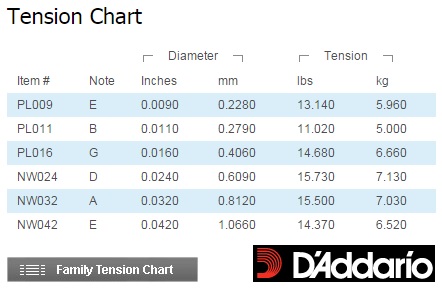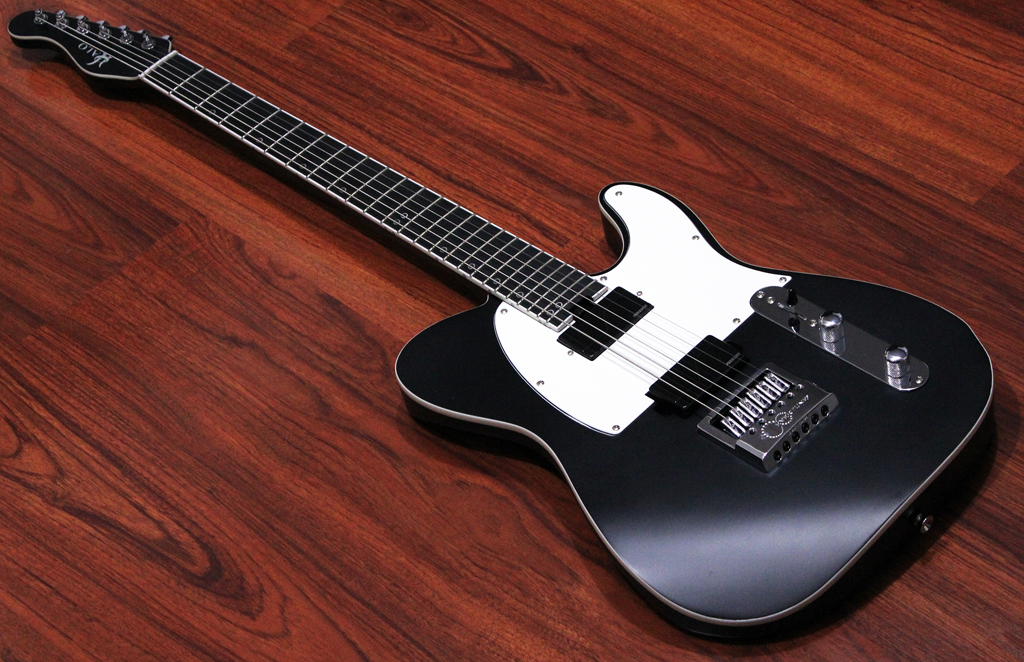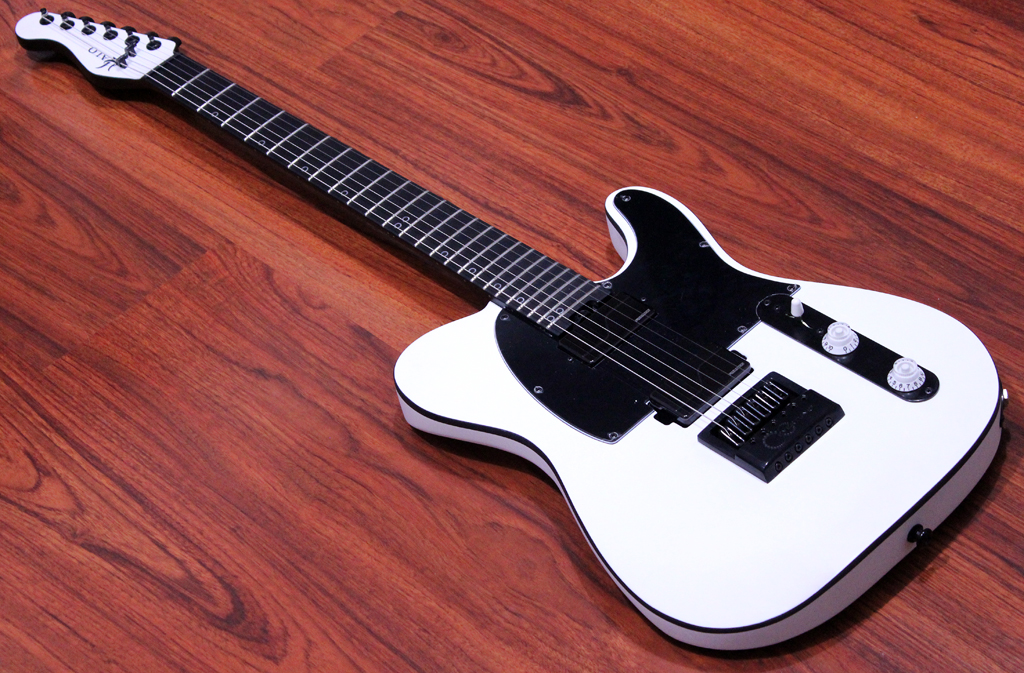Baritone guitars are great for drop tuning (think Low B or lower) because their longer scale lengths make the strings feel, sound and intonate better.
Most of us started playing the guitar on a 6-string tuned to E Standard (EADGBE). Eventually, we started experimenting with alternate and Drop D tunings and the guitar handled it just fine. But, some of us wanted to go even lower... say, B Standard, Drop A, or even F# Standard. That's when we started noticing problems:
- Lowest string felt too floppy
- Lowest string sounded too muddy/boomy
- Lowest string intonated poorly
Standard guitars weren't designed for super low tuning.
Without getting too technical, I'll just say this: lower notes require longer and thicker strings, while higher notes require shorter and thinner strings (that's why bass guitars are bigger than standard guitars). It's important to note that the lowest tuned strings are now getting into a frequency range that really isn't great when played on a standard guitar (assuming B Standard tuning or lower). In fact, they have already gone well into bass guitar territory... This is where the baritone guitar comes into play wonderfully.
Baritone guitars fill the gap between standard guitars and standard basses wonderfully.
The distinguishing feature setting baritone guitars apart from other guitars is their scale length. The scale length is determined by measuring the distance from the front side of the nut (where it joins the front of the fretboard) to the center of the 12th fret, and then multiplying that measurement by two. Standard guitars have a scale length of around 25"; standard basses are around 34". Baritone guitars, then, will have a scale length somewhere in between 25" and 34".
So, what's the best baritone guitar scale length?
Because baritone guitars are normally used by guitar players that want to play in lower tunings, and not by bass players that want to play in higher tunings, the overall feel of a baritone should be more like a guitar than a bass. For that reason, many of our baritone guitars are designed with 6 strings and a scale length falling somewhere between 27" and 30", depending on the tuning we're trying to achieve. I mention 6 strings because some folks think they need a 7-string guitar in order to tune down to Low B, and an 8-string guitar in order to tune down to Low F#, or beyond. But, this is not true, as we have just learned the key factor in improving the feel/tone/intonation at these super low tunings is the scale length, and not the number of strings on a guitar.
How does the scale length improve the floppiness, tone and intonation of the lowest string?
The key factor is string tension (measured in pounds). There needs to be enough string tension in order to get a good feel, tone and intonation. Scale length makes a significant impact on string tension. To determine string tension, let's focus on three variables:
- Scale Length
- String Gauge
- Tuning
String tension increases when any of the above variables increases. To get a benchmark idea, let's take a look at the string tension for a standard guitar with D'Addario Super Light Gauge strings, tuned to E Standard:

Let's focus on the Low E Note:
- The Scale Length is 25.5"
- The String Gauge is 0.042"
- The Tuning is Low E (82.4 Hz)
We see from the chart that these variables result in a Low E String Tension of 14.37 pounds. This number might not be useful by itself, so here's a chart showing the differences in string tension when we change the string gauge (scale length and tuning remain the same):

OK, great - we can easily see that increasing the gauge increased the string tension. But, perhaps we already knew that. What we're concerned with now is what happens when we tune our guitars down to say, Low B. Here's a chart showing what happens to the string tension when we change the tuning to Low B (scale length and string gauge remain the same):

Yikes. We see that a standard guitar tuned to Low B will feel pretty wimpy even when strung with Extra Heavy gauge strings (Jazz Medium's, aka 13's). At this point, we only have two options to increase the tension and they are (1) to increase the string gauge even further, or (2) to increase the scale length. If we increase the string gauge further, then the tension will, indeed, feel better, but the tone and intonation will suffer. In our scenario, as the string gets thicker, the tone becomes boomier and less crispy/crunchy. The crispy/crunchy tone is what helps make an electric guitar sound like an electric guitar, and not a bass. In addition, the thicker strings might become impossible to intonate (thicker strings require the string saddle to be positioned further away from the nut in order to intonate properly, and often times there just isn't enough space physically on the bridge to allow for this amount of compensation). So, we're stuck with a guitar that doesn't intonate properly, and that makes for a bad sounding guitar.
This leads to the only remaining option: change the scale length. Unfortunately, a guitar can only be built with one scale length (let's ignore multi-scale instruments for now) and it cannot be changed once it's built. This is why baritone guitars are the perfect solution for those seeking to tune their guitars down to Low B and beyond - their scale length increases the string tension, which allows for a good feel, a good tone and proper intonation.
Let's take a look at what happens to the string tension when we increase the scale length (Low B tuning remains the same, and focus only on the heaviest string gauge: 0.056"):

Scale length increases string tension
Bingo. That's what we need. The increased scale length of a baritone guitar enables us to tune down to Low B and use a reasonable sized string, which helps us to:
- eliminate floppy low strings
- eliminate muddy/boomy sounding low strings
- eliminate poorly intonating low strings
If you're going to be tuning to Low B or lower, then you should seriously consider a baritone guitar, which is essentially just a 6-string guitar with a longer scale length. The longer scale length improves the overall feel, tone and intonation for those low tunings.
Check out some of our baritone guitars:
Your email address cannot be published. Required fields are marked*




Great article. However, I still don't understand how far I can go with the gauge for E standard on a 25.5" guitar. Is a set of 012-54 safe for E standard tuning on a 25.5" guitar? Thanks!
*** Halo Admin Reply: 12-54 is safe for E standard at 25.5", but your guitar should be slightly adjusted to accommodate it. First, the nut slots need to be large enough to fit the larger strings. Second, the truss rod will probably need to be adjusted to handle the extra tension. Third, the string saddles probably need to be adjusted slightly further away from the nut for proper intonation (assuming the saddles were already set for proper intonation with a lighter gauge). Hope this helps! - Jeff Lee, Halo ***
I just got a Fender Jaguar Baritone Custom and I'd like to tune to drop A. What would you recommend for string sizes? It has a 28.5" scale. Thanks!
*** HALO ADMIN RESPONSE: Hi Paul, I'd probably use 13-17-26-36-46-59, and if the Low A is too loose, then increase just that one string to maybe a 62, 64, or somewhere around there. Hope this helps! - Jeff Lee ***
Great article, very informative. I have a baritone 7 string, and I am finding it difficult to find baritone 7 string sets. My guitar has a reverse headstock, so the lowest string tuning machine is the furthest one. This is my first baritone 7 string so I don't know what I am looking for in string length. Do I need baritone sets or will regular guitar strings be long enough?
*** HALO ADMIN RESPONSE: We build multiple models of 7-string guitars with 27" scale length and reverse headstocks, and we've never had a problem with installing retail packs of D'Addario EXL110-7's on them. We've also used retail packs of Dunlop 7-string sets, RotoSound, Ernie Ball, and haven't had any issues, either. So, I don't think it'll be necessary for you to buy baritone string sets. Hope this helps! ***
Hi, im a beginning guitar player and would like to know wheter baritone guitar are considered a good plan to learn pickings on ? What exactly makes the sound and feel of a longer scale to be tuning just like a E-standard or playing that way ? thanks just don't shoot me for being imbecile
* HALO ADMIN RESPONSE: Sorry, but I can't quite understand what you're asking. Please email me directly at jeff at haloguitars.com and I'll try to assist further. But, no, I don't recommend learning guitar on a baritone. I recommend learning guitar on a standard guitar. Hope this helps! ***
i just ordered a ltd Eclipse baritone guitar (27") and im wondering im wanting to tune down to B standard what strings do i use like guage wise i noticed guys using 4 wound strings like from a 7 string set then normal non wound. can someone help me out??
*** HALO ADMIN RESPONSE: We often install D'Addario EXL110-7 Nickel Wound, 7-String, Regular Light, 10-59 gauge strings on our 27" scale 7-string guitars. I'd say give them a try! ***
Hi! This article is great thank you! I just had 2 questions, my situation is very specific, I'm actually designing my own baritone guitar, buying parts and assembling myself, my goal is to design a guitar to hold the following tuning, G D G C F Bb. My questions, Will a 28 5/8 scale be enough to give me a firmer string, similar tension to what you'd see on a normal guitar tuned to E with gauge '11' strings, and what gauge string would I need to give it that?
*** HALO ADMIN RESPONSE: A great tool for determining the answer to your question is String Tension Pro - here's the link: http://stringtensionpro.com/ Good luck with the build, and I hope this helps! ***
How about C# standard on a 27" scale? Basically the Agile 2000. On my 25.5" I use beefy slinkies or not even slinkies.
*** HALO ADMIN RESPONSE: Personally, C# Standard could be just fine for standard guitars (e.g. 25.5" scale), but it's okay for 27" too. Hope this helps! ***
I have a 27.7 inch scale Baritone guitar its a PRS 277. I want to tune it to Drop A#. What string sizes should I use to achieve good tension? Thanks.
HALO ADMIN RESPONSE: It depends on what you consider "good" - shoot me an email at jeff at halo guitars dot com and I'll be glad to assist you further. Or, check out this string tension calculator http://stringtensionpro.com/ Thanks!
To accomplish Drop B tuning on a standard 22 fret Strat neck build, is it necessary to position the bridge beyond 25.5? Is a baritone neck needed for scales beyond 25.5 or will this neck intonate just fine with the bridge pulled back to say 26 or 27? I'm slapping a strat neck on a mustang body and getting ready to set the hardtail.
HALO ADMIN RESPONSE: In response to your first question: It is most important and necessary to place the bridge in such a way that most of the bridge's saddles can be adjusted so they sit right around 25.5" or up to 1/4" beyond in order for them to intonate properly at Drop B.
I'm not sure how to respond to your second question because I'm not sure I understand your question, unfortunately.
Generally speaking, the bridge needs to be placed in such a way that the High E string's saddle can be adjusted to sit right around the given scale length (e.g. for a standard 25.5" Strat neck, the High E needs to be set right around 25.5" in order to intonate). In addition, the bridge needs to be placed in such a way that the Low E string's saddle can be adjusted to sit right around the given scale length + 3/16" to 1/4" (e.g. for a standard 25.5" Strat neck, the Low E needs to be set right around 25.5" + 3/16" in order to intonate; as you start doing drop tunings, you'll need to adjust it even further back, so a Low B string might need to be set right around 25.5" + 1/4" in order to intonate). Hope this helps!
Excellent info! I'm working on specs for a custom build. I've always loved the treble/bridge tone of the Les Paul Custom, but prefer a Dropped C tuning (CGCFAD). I tried just swapping the strings on my LPC from a 10-46 set to 11-54, but man, it killed the snap of the attack, and pushed the lower strings into the muddy/boomy range. So I'm wondering what gauge of strings I should opt for, and what scale length would be ideal to retain the snappiness of the attack, the nice harmonic resonance when picking palm-muted, and the brighter mid tone of a standard gauge/tuning, but with a Dropped C tuning. Any suggestions? Also, it'll have an EverTune bridge, so not too worried about strings being a little too light & pitch bending up if I pick/fret too hard. Just need to determine the ideal gauges & scale to retain the tone and the attack without things getting floppy/loose, buzzy, or badly-intonated. Thanks for any help you can give!
[HALO ADMIN RESPONSE]: I would try something with a 25.5" to 27" scale with 11's or 12's! Hope this helps! - Jeff Lee
I love 46-9 for drop d and e standard on 24.75 and 25.5, curious what would be about the same feel on a 28" scale for drop a and b standard?
HALO ADMIN RESPONSE: To get approximately the same feel, you'd want to get approximately the same amount of tension. So, first go to http://stringtensionpro.com/ to determine the string tension you get with your 46-9 setup. Then, change the settings to a 28" scale, change the tuning, and experiment with different gauges until you reach approximately the same amount of tension. Hope this helps! - Jeff Lee, Halo
I'm about to get a 28.5" scale Fender Jaguar Baritone, can anyone recommended me a string set or gauges for the 6 strings so that I could tune it DGCFAD? I was thinking of taking the gauge I'd use for a standard A to A baritone tuning and just using the 5 thinnest strings from that set but I guess then I'd need to separately buy a light gauge string for the highest D?
HALO ADMIN RESPONSE: I'd suggest the D'Addario EXL110BT set for that scale length and tuning because it would feel very similar to a set of 10-46 on a 25.5" scale tuned to EADGBE.
Hello. Great article! Great info! Thanks! I'm planning on replacing a neck on a stratocaster type guitar with a 30.25" scale length neck to convert it to a baritone. What string gauges would I need to achieve proper intonation to tune it to G standard?
HALO ADMIN RESPONSE: Hi Matt - for proper intonation, it's first critically important that you use a baritone conversion neck, like Warmoth offers. Otherwise, it will never intonate properly (regardless of the strings you use) if you simply bolt a 30.25" regular (non-conversion) neck to a guitar that was originally designed for a 25.5" scale. I would check out stringtensionpro.com to determine the combination of scale length, string gauges, and pitch that will generate the amount of tension that you like. Hope this helps! - Jeff Lee, Halo Custom Guitars
Wicked article! I have a Fender Bass VI tuned AEADEA - which is DADGAD but baritone lol and want some 14-74 gauge strings but cant find any long enough. Ernie Ball strings are good up until my last 2 high strings and Jim dunlop stings are long enough but the winding doesn't run for the entire 30 inches leaving me with one string thats half wound and fully wound. At the moment Im just mixing the two sets and although its a suitable option, I don't want to continue to buy an extra set of strings just to use a singular string. Do you guys know of any string sets that are around 42 inches in length with winding that runs the entire length of the string?
HALO ADMIN RESPONSE: Hi Alex - We bought some of our strings in bulk singles from Dunlop and the fully wrapped length was about 37". Unfortunately, I'm not sure about retail string sets. I'd try reaching out to the various string manufacturers for that info! Thanks! - Jeff Lee, Halo
Hello! Great article! For a tuning in Drop C (CGCFAD), does a baritone guitar work? What length of scale do you suggest for this tuning?
HALO ADMIN RESPONSE: Drop C isn't too low and I'd say a standard 25.5" scale is still okay. I'll usually start considering a baritone once I get down to a Low B or lower. Hope this helps. - Jeff, Halo
This might sound like a stupid question but can I tune my ESP Ltd Baritone guitar to drop A#? Or at least B#? Any comments would help. Thanks!
HALO ADMIN RESPONSE: Yes, you can do that. I'd suggest heavy gauge strings, or baritone strings. These would usually be 13's or 14's. Have fun! - Jeff Lee, Halo Custom Guitars
Hello, haloguitars! I love this article, it's really informative! 2 questions: 1. I watched a lot of demos of baritone guitars and I really love the sound of them. I already have a 25.5 7 string, and while it's fun and inspiring to play, I feel like I still want to go back to the good ole 6 string on some days. However, my favourite 6 string tuning is drop b. Is drop b too high for a 28inch baritone guitar or will I have absolutely no troubles setting that up properly? If so, what are the string gauges? Is there some general guideline for tunings of baritone guitars? 2. Regarding the strings and headstocks of baritones... I've looked at different baritones and they have the headstock reversed - the lowest string tuner is furthest, etc. Why ? Also, are the baritone string packs actually different strings specifically designed for baritones, or could you actually use any guitar strings for 28 inch scale baritone?
HALO ADMIN RESPONSE: Drop B is not too high for a 28" scale baritone guitar. There is no universal standard for string gauges, but here's my personal preference for Drop B at 28": B-F#-B-E-G#-C# => 59.42.32.20P.16.12. Regarding reverse headstocks and non-reverse headstocks... my opinion is that it is mostly for aesthetics. Some people will discuss there being a measurable difference in tension, but I don't think too much into that. Regarding strings - I could imagine some string makers could consider the core thickness and the wraps when making their baritone strings. However, in practice, I've used a variety of conventional (non baritone) guitar strings of various gauges without issues. I just stick with my preferred gauge of nickel round wound strings from any of the major string manufacturers and have been fine. Hope this helps - Jeff Lee, Halo Custom Guitars
Hi Jeff, I just purchased a PRS SE Mike Mushok Baritone. It's a 27.7" scale. I've been eyeing up getting a baritone for a while, and this article has been very instrumental in my decision and very informative. I believe the guitar is strung with 68-14 D'addario EXL157. My question is, I like to tune to C Standard, but my other 6 string is a 25" scale. I have matched the tension to that of my preferred option (using StringTensionPro site) and have purchased a 54-12 set (yet to put on it). Could the baritone handle C Standard better? Thanks, Steve
HALO: Both will handle C Standard better. The baritone will be more sizzly than then standard 25.5" because the baritone will have lighter gauge strings.
I am thinking about buying a gretsch 30" baritone and I wonder if you can comfortably tune it to drop A or if the neck is too long? Also what strings should I use?
Hi Olle - not too long at all. What strings you use depends a lot on what tension you prefer. You can try this tension calculator from String Joy: https://tension.stringjoy.com/
Hope this helps!
Jeff Lee, Halo Custom Guitars